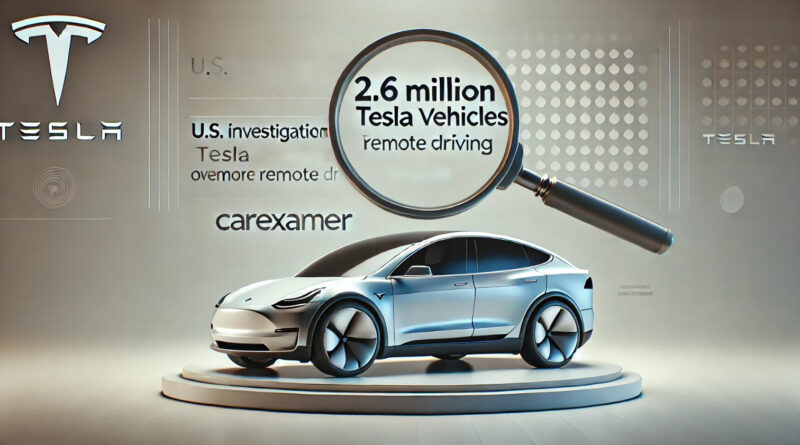U.S. Investigates 2.6 Million Tesla Vehicles Over Remote Driving
Here’s what you need to know about the U.S investigates Tesla, what it could mean for Tesla, and how it might shape the future of autonomous vehicles. Tesla is no stranger to being in the spotlight, but this time it’s for its remote driving feature, with the U.S. National Highway Traffic Safety Administration (NHTSA) launching an investigation into 2.6 million Tesla vehicles. While Tesla’s innovations in autonomous technology are often celebrated, this probe raises questions about safety and how these cutting-edge features are used.
What’s the Issue with Tesla’s Remote Driving Feature?
Tesla’s remote driving feature, part of its Smart Summon and Full Self-Driving (FSD) systems, lets you control your car from your phone. Imagine summoning your car to pick you up in a parking lot or maneuvering it short distances without being in the driver’s seat. Sounds futuristic, right?
But this technology isn’t perfect. Concerns have surfaced about how the system behaves in real-world scenarios, with reports suggesting that cars may stop unexpectedly, move unpredictably, or even fail to detect pedestrians or obstacles.
Why Is the NHTSA Investigating?
The NHTSA’s investigation is rooted in safety concerns. While Tesla has marketed these features as advanced and convenient, complaints from drivers and observers suggest there may be risks involved.
What Are the Concerns?
- Unintended Movements: Vehicles in remote mode may behave erratically, like stopping or turning unexpectedly.
- Pedestrian Safety: Some reports suggest the system doesn’t always detect pedestrians or other hazards.
- Driver Responsibility: Questions remain about whether drivers fully understand their role when using these features.
Which Tesla Models Are Under Review?
The investigation covers Tesla’s major models equipped with remote driving features:
- Model S
- Model 3
- Model X
- Model Y
These vehicles represent a significant chunk of Tesla’s production over recent years, making this probe one of the largest of its kind.
What Could Happen Next?
Tesla’s cutting-edge technology has faced regulatory scrutiny before, but this investigation could lead to notable consequences:
1. Possible Recalls
If the NHTSA finds safety issues, Tesla may need to issue recalls or make software updates to address the problems.
2. Tighter Regulations
The investigation could result in stricter rules for how remote and autonomous features are designed, marketed, and monitored.
3. Impact on Reputation
Tesla’s brand is built on innovation, but frequent safety probes could raise concerns among potential buyers.
How Is Tesla Likely to Respond?
Tesla hasn’t issued a public statement yet, but based on past experiences, it’s likely the company will lean on its over-the-air software updates to address any issues.
Tesla has previously emphasized that its features, including Smart Summon and FSD, require driver supervision, meaning users are still responsible for the vehicle’s behavior. This investigation may push Tesla to clarify or enhance those expectations.
What This Means for Tesla Owners
If you’re a Tesla owner, this news might raise a few questions. Here’s what you should know:
- Keep Software Updated: Tesla regularly releases updates to improve its systems, so make sure your car is running the latest version.
- Use Features Responsibly: Tesla’s remote driving is not fully autonomous—always supervise your vehicle closely when using it.
- Watch for Recalls: Stay informed about the investigation’s progress and follow any instructions if your car is affected.
The Bigger Picture for Autonomous Driving
Tesla’s journey with autonomous and semi-autonomous features highlights the growing pains of introducing cutting-edge technology to everyday driving.
1. Regulatory Challenges
The balance between fostering innovation and ensuring safety is becoming a central issue for regulators like the NHTSA.
2. Public Education
There’s a gap between what drivers expect from features like Smart Summon and how they’re meant to be used. Educating users could prevent misunderstandings and accidents.
3. Industry Impacts
As one of the leading players in the EV and autonomous vehicle space, Tesla’s challenges will likely shape how other manufacturers approach similar technologies.
Tesla’s Track Record with Safety Probes
This isn’t Tesla’s first run-in with safety investigations. Over the years, the company has faced scrutiny for its Autopilot system and other autonomous features. However, Tesla’s ability to implement software updates has often allowed it to address issues quickly, minimizing disruption to customers.
What’s Next for the Investigation?
The NHTSA will analyze data, review complaints, and determine if Tesla’s remote driving features pose significant risks. The outcome could lead to:
- Recalls or mandatory updates for affected vehicles.
- New regulations for remote driving and autonomous features.
- Broader industry changes to how these technologies are developed and marketed.
There’s no set timeline for the probe, but its findings could set important precedents for the future of autonomous vehicles.
Final Thoughts
Tesla’s remote driving feature is undeniably impressive, but the NHTSA’s investigation reminds us that innovation must go hand-in-hand with safety. While this probe could pose challenges for Tesla, it also offers an opportunity to refine its technology and strengthen trust with its customers.
For Tesla owners, the key takeaway is to stay informed and use these features responsibly. For everyone else, this investigation is a critical moment in the evolving story of autonomous driving—one that underscores the complexities of balancing cutting-edge tech with real-world safety.
Buying a used VW. Buying used vauxhall, BMW, Jaguar, Ford, Volvo, Range rover, Bentley, Aston Martin, Porsche, Ferrari, Lamborghini, Maserati, Hyundai, Tesla, Honda, Pagani

